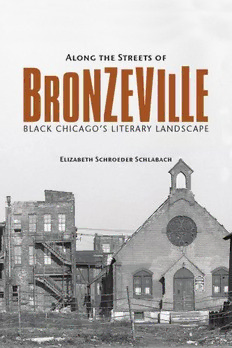
Along the Streets of Bronzeville: Black Chicago’s Literary Landscape PDF
Preview Along the Streets of Bronzeville: Black Chicago’s Literary Landscape
Along the Streets of B Z V L N E I E O L R BLACK CHICAGO’S LITERARY LANDSCAPE Elizabeth Schroeder Schlabach along the streets of bronzeville Schlabach_AlongtheStreets_text.indd 1 5/6/13 1:29 PM the new black studies series Edited by Darlene Clark Hine and Dwight A. McBride A list of books in the series appears at the end of this book. Schlabach_AlongtheStreets_text.indd 2 5/6/13 1:29 PM along the streets of bronzeville Black Chicago’s Literary Landscape Elizabeth Schroeder Schlabach University of Illinois Press Urbana, Chicago, and Springfield Schlabach_AlongtheStreets_text.indd 3 5/6/13 1:29 PM © 2013 by the Board of Trustees of the University of Illinois All rights reserved Manufactured in the United States of America c 5 4 3 2 1 ∞ This book is printed on acid-free paper. Library of Congress Cataloging-in-Publication Data Schlabach, Elizabeth Schroeder. Along the streets of Bronzeville : black Chicago’s literary landscape / Elizabeth Schroeder Schlabach. pages cm. — (The New Black Studies Series) Includes bibliographical references and index. isbn 978-0-252-03782-5 (cloth : acid-free paper) isbn 978-0-252-09510-8 (ebook) 1. American literature—Illinois—Chicago—History and criticism. 2. American literature—African American authors—History and criticism. 3. African Americans—Illinois—Chicago—Intellectual life. 4. Chicago (Ill.)— Intellectual life—20th century. I. Title. ps285.c47s35 2013 810.9'977311—dc23 2013012803 Schlabach_AlongtheStreets_text.indd 4 5/6/13 1:29 PM For my family—past, present, and future. Schlabach_AlongtheStreets_text.indd 5 5/6/13 1:29 PM Schlabach_AlongtheStreets_text.indd 6 5/6/13 1:29 PM Contents Preface ix Acknowledgments xxi Chapter 1. From Black Belt to Bronzeville 1 Chapter 2. The South Side Community Art Center and South Side Writers Group 25 Chapter 3. Policy, Creativity, and Bronzeville’s Dreams 50 Chapter 4. Two Bronzeville Autobiographies 75 Chapter 5. Kitchenettes 94 Conclusion 118 Notes 127 Bibliography 149 Index 159 Schlabach_AlongtheStreets_text.indd 7 5/6/13 1:29 PM Schlabach_AlongtheStreets_text.indd 8 5/6/13 1:29 PM Preface Gwendolyn Brooks, a lifelong resident and Bronzeville native, once wrote, “If you wanted a poem, you had only to look out of a window. There was material always, walking or running, fighting or screaming or singing.”1 Brooks did an interview much later in life where she was asked if she were disturbed by this environment to which she replied, “In my twenties when I wrote a good deal of my better-known poetry I lived on 63rd Street—at 623 East 63rd Street—and there was a good deal of life in the raw all about. You might feel that this would be disturbing, but it was not. It contributed to my writing progress. I wrote about what I saw and heard in the street. I lived in a small second-floor apartment at the corner, and I could look first on one side and then on the other. There was my material.”2 She recalled receiving the letter at this address from publisher Harper and Brothers ac- cepting A Street in Bronzeville for publication, after which she ran into her kitchenette apartment building’s “community bathrooms, locked the door, and gasped through the gold of a firm acceptance.”3 Poverty-stricken, segregated, and bursting at the seams with migrants— Brooks’s Bronzeville is the community that provided inspiration, training, and work for an entire generation of diversely talented African American authors and artists who came of age during the years between the two world wars. Willard Motley, poet, novelist, and nephew of famed painter Archibald Motley Jr., the first African American trained at the Chicago Art Institute, wrote, “There is a small group of young Negro artists in Chicago that will be heard from one of these days. At present they are struggling in garage and top-floor tenement studios. . . . They paint for the love of it. There is much talent in the group.”4 Many of these artists and authors went on to become the leading names in their fields and in so doing earned for the United States a reputation as the creative wellspring of twentieth-century African American art and literature. Yet, until late, the majority of Chicago’s Schlabach_AlongtheStreets_text.indd 9 5/6/13 1:29 PM
